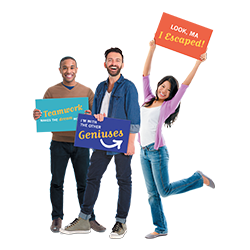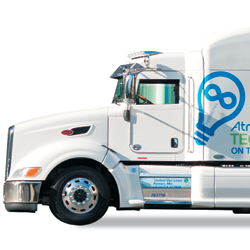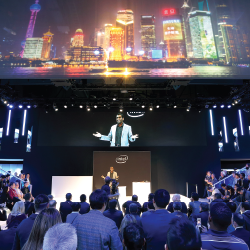|
case study
 Mind Games
To boost awareness, booth traffic, and media attention, the Institute of Electrical and Electronics Engineers creates an ingenious mind-control drag-racing activity. The experience attracts more than 1,000 participants, retains them for an average of 20 minutes each, and generates 80,377 new Facebook fans. By Linda Armstrong
Epic battles are often won with a delicate balance of brain and brawn. But at the International Consumer Electronics Show, the battle for attendee attention often pits wow factor against humdrum – and wow factor always wins. That's a significant challenge, then, for exhibitors who aren't hawking the newest smartphone or the techiest, tricked-out drone. For even being heard above the din of other exhibitors' bells and whistles, much less standing out and attracting interested attendees, is as difficult as David trying to arm wrestle Goliath.
Going into CES 2015, the Institute of Electrical and Electronics Engineers was the David in that wow factor versus humdrum death match. As the world's largest technical professional society, whose mission is the advancement of technology for the benefit of humanity, IEEE (pronounced "I" triple "E") has more than 426,000 members in 160 countries. With roots dating back to 1884 and members including everyone from Thomas Edison to Andrew Grove (a semiconductor pioneer and former CEO of Intel Corp.), the institute comprises 39 different societies, sponsors 1,600 conferences in 91 countries, and publishes more than 30 percent of the world's technical literature on electrical engineering. Plus, its online digital library, Xplore, offers upwards of 3.5 million documents, from which more than 8 million downloads are retrieved each month. But despite its vast contributions to the world, few people outside of the electrical and electronics industries have ever heard of IEEE, which is why the organization turns to massive shows like CES to generate awareness. "The aim of the exhibit-marketing department at IEEE is to generate visibility and to help the world understand how our members contribute to society," says Ann Townley, the institute's manager of integrated marketing. "We want to be known as thought leaders, enablers of innovation, and drivers of future technology. And we use shows like CES to promote ourselves and our members." Over time, then, IEEE hopes that this marketing program will also increase membership, foster conference attendance, drive publication sales, etc. But how does a no-nonsense nonprofit generate visibility when sexy consumer products are "twerking" all around it? Or to put it another way, how does David overpower Goliath? For IEEE, the answer was to use its own members and its internal brainpower to outsmart the competition. Electrical Issues IEEE's solution, however, actually began with a few missteps starting prior to 2012. Back then various groups within IEEE insisted on exhibiting at CES independently, a tactic that seemed to short out its broader awareness aims. For example, on the same trade show floor, attendees might have found a booth branded as the IEEE Consumer Electronics Society, another as the IEEE Computer Society, and a third as the IEEE Standards Association. Attendees were rightfully confused about the organization and why its groups appeared to be disconnected. The multiple exhibits grounded out the organization's efforts, creating more uncertainty than awareness. 
Start Your Engines
Starting in 2012, however, IEEE purchased a 20-by-20-foot booth to promote the entire institute. While some internal groups still had their own exhibits, the addition of a corporate booth was a solid step toward creating a central presence. In 2013, the organization took another stride by integrating all groups into an expanded 30-by-40-foot exhibit. This year also marked the introduction of what Townley calls a "sizzle element."The Institute of Electrical and Electronics Engineers developed a mind-controlled drag-racing experience that used attendees' brain waves to move remote-controlled cars. The one-of-a-kind activity employed a headset from Emotiv Inc. that wasn't even on the market at the time of the event. "We quickly realized that we needed to offer people some kind of one-off experience that would set us apart, force attendees to hit 'pause' on their show-wide quest for the next big thing, and give us the wow factor that is inherent in so many consumer-electronics products," Townley says. "This sizzle activity would have to engage people long enough for us to explain IEEE. Plus, it needed to reinforce our role as thought leaders and drivers of future technology as well as generate press attention." In 2013, IEEE debuted its first sizzle element: a helio-display of Thomas Edison. Essentially a two-dimensional display that appeared to float in air, the attraction drew tons of onlookers and set a high bar for the next year. But in 2014, IEEE topped itself by creating a full-size humanoid robot named RoboThespian, which walked and talked, explaining IEEE and even acting out movie scenes. "This experience drew amazing media attention and went a long way toward generating coverage in several top-tier broadcast outlets, including The Weather Channel and the Discovery Channel," says Andrew Corcione, vice president and creative specialist at Finn Partners, the communications agency charged with public relations and social-media efforts for IEEE's trade show presence. For CES 2015, IEEE's sizzle element had to meet all of the aforementioned challenges, but it also needed to be scalable to different environments. To minimize shipping expenses, the organization wanted to take a smaller rendition of the experience to its international shows, which included Futurecom in Sao Paulo, the International Broadcasting Convention in Amsterdam, and Mobile World Congress in Barcelona, Spain. 
To establish baseline measurements of participants' brain waves, staffers fitted them with the neurological headsets and asked them to first think neutral, calming thoughts, followed by repetitive, exciting thoughts. To propel their cars, racers mimicked the same excited thoughts they had during training. Calm thoughts kept the cars in place.
IEEE found its answer via solid research and clever brainstorming. "In 2014, we did a broad analysis of the audiences we interact with via social media," says Mickey Young, IEEE marketing specialist. "Two hot topics came to the forefront of our research: brain-related technologies and intelligent transportation. So we tried to devise a way to communicate our forward-thinking message about IEEE with some kind of brain- and car-related technology."After generating a few low-voltage ideas, the IEEE marketing team hit a live wire: mind-controlled drag racing, a concept that combined the two topics identified in IEEE's social-media research. The team was familiar with Emotiv Inc. (a bioinformatics firm that has numerous IEEE members in its ranks, including C-level managers, engineers, and chip designers), which had developed a neurological headset that records brain waves, transforms them into data, and then communicates them to computers or other electronic devices. While the technology can be used to monitor health factors, e.g., relaxation, stress, focus, etc., it can also be employed to maneuver objects using brain waves as the controller, just as you might use a handset to steer a drone. So Corcione and his colleagues figured they could partner with Emotiv to create a game whereby attendees used their brain waves to race remote-controlled cars down an in-booth racetrack. "To communicate forward thinking, we could literally make people think 'forward' with this type of activity," he says. What's more, Emotiv's technology was not yet available to consumers at the start of CES 2015, so the proposed in-booth activity would be a one-off encounter that attendees had never before experienced. And with that, IEEE's Thinking Forward campaign was born. Amping Up To rev up attendees' engines about its new activity while also creating a bit of intrigue around it, IEEE sent an email teaser to the show's preregistered attendees and the press roughly a month before the show. The email contained the words "Thinking Forward" along with an image of a human head full of gears. Text invited people to IEEE's booth and listed various ways that the institute has impacted the world with its forward-thinking technology. It also hinted at the booth activity by suggesting recipients take a "head's on" demo and do some forward thinking of their own. In addition, the email included a link to a 34-second video that teased the activity even further. Comprising images of an animated speeding car and a show-floor map indicating the booth location, the video ended with the spoken words "We'll have cars so smart that they'll make you think." When the doors flung wide at CES 2015, attendees and media reps laid rubber heading to the booth. Arriving at the 30-by-40-foot exhibit, which was designed by Taylor Manufacturing Industries Inc. (aka The Taylor Group), visitors discovered two L-shaped signs suspended over the space. Featuring the organization's blue and green hues, the fabric banners offered the IEEE logo and the words "The Force Behind Innovation" in bright white letters. Designers positioned six kiosks around the booth perimeter, each of which offered attendees info on the various groups within IEEE. However, the spotlight attraction was a couldn't-miss racetrack situated front and center in the space. Surrounded by waist-high metal railings, the 4-by-20-foot track comprised two computer monitors on the starting end, two miniature racing cars positioned atop the track, and a finish line complete with checkered-flag graphics on the other end. IEEE had also scattered multiple leader boards (which would showcase the fastest race times, IEEE's URL and hashtag, and a countdown to the start of each race) throughout the space. 
Leader boards placed throughout the exhibit identified the fastest times and counted down to the next head-to-head competition.
Drawn to the track like tires to the groove, attendees cued up for the drag-racing experience near the starting line. Working with two racers at a time, an Emotiv staffer fitted each racer with a headset. After scanning the racers' badges, another staffer walked them through a 15-second training procedure. "We instructed each participant to think of something neutral and calming," Young says. "This allowed the individual headsets to measure each racer's unique brain waves in a state of calm to establish a baseline reading. Then we asked racers to think of something repetitive or exciting, and the headsets repeated their measurements in this focused or 'push' state." During the race, the calm brain waves made the mind-controlled car stall, while the focused thoughts made it move forward. The neurological headsets gathered brain wave signals, translated them into the "stop" or "go" messages, and wirelessly communicated those messages to a receiver connected to a computer, which then controlled the cars. Once the headsets were calibrated to each user's thoughts, the racers stepped up to the starting line and watched a leader board positioned at half track, which showed the words "ready," "set," and "go," the latter of which started the timer. Racers then tried to focus on the same repetitive or exciting thoughts they'd established during the training. "Often, racers thought about things related to 'go' or forward motion," Young says. "But then the cars didn't go anywhere. Instead, racers had to replicate the same brain waves from training – and that can be pretty difficult when there's a crowd of people watching you try to 'think' a car down a racetrack. For some people it was a piece of cake; for others, not so much." For those racers having trouble, a computer-generated voice cheered them on. "A PC connected to the game called each racer by name (courtesy of data from the previous badge scan) and said things like, 'Let's go, Mike!' or 'Come on, Stacy!'" Young says. As cars crossed the finish line, each racer's time was posted on the track's monitors, and a camera positioned atop the leader board snapped a photo of the racer's expression. IEEE immediately emailed this branded photo to each corresponding racer. The email thanked recipients for visiting the IEEE booth and provided links to additional information about the institute as well as navigation buttons that allowed recipients to quickly share the photo on Facebook or Twitter. In addition, the person with the fastest time recorded during the show won a headset from Emotiv once the devices became available to the public. 
Fast and Curious
All told, IEEE hoped 500 people would participate in the activity; however, it doubled that mark, as more than 1,000 people took part over the course of the show. But perhaps more important than the number of participants the activity drew was the amount of time each one of them spent digesting in IEEE's messages. "On average there were 15 people waiting to play the game at any given time in the booth," Young says. "But sometimes we had up to 30 people standing in line." Staff took full advantage of the lines by talking with waiting attendees and touting IEEE's offerings. "People stood in our space and soaked up our branding and messages for an average of 20 minutes," Young says. Those minutes were also a huge jump from the average of four or five minutes attendees spent engaged with IEEE's sizzle activities in 2013 and 2014.The 20-foot drag-racing strip sat front and center in IEEE's 30-by-40-foot exhibit. Surrounded by waist-high metal railings, the track allowed attendees to crowd around it to watch the action. High-Voltage Happenings After each race, staff as well as text on the leader boards urged players to check out the rest of the booth and test drive two activity stations within the space: Game Changers and the DIY Project. Hosted at a kiosk, Game Changers was an app offering a product-building adventure. "People could access the app through our Facebook page or a special microsite, so fans at home as well as those at the kiosk could take advantage of this experience," Young says. Players made a series of choices to create a new technology, and based on their decisions, they earned a specific number of points. For example, a competitior might gain points for a product that improves humanity but lose them for costly production-related decisions. "The activity tracked participants' scores and posted them within the app," Young says. "Game Changers was a way for people to interact with IEEE, to show off what they knew about technology development, and to earn cold hard cash." Booth visitors who played the game, as well as those who competed in the mind-control drag-racing activity, were entered in a drawing to win a $500 Amazon gift card, and at-home players could win a $100 card via a separate drawing. 
Racers used branded toy cars featuring IEEE's corporate colors of green and blue.
Meanwhile, the IEEE DIY Project was part of an ongoing program to encourage people to showcase technology-related inventions they've built at home, including everything from robotic arms to automatic air humidifiers. Once again, people could enter through IEEE's Facebook page and microsite, via their own smartphones or computers, or at a kiosk in the booth. The entry process merely involved submitting a description along with photos or videos of their completed DIY creations. The contest ended in March 2015, when a panel of more than 25 judges, comprising representatives from IEEE, Finn Partners, and Google Inc., analyzed the entries. Three winners were selected randomly during each week of the campaign, each of which received a $50 Amazon gift card, and one grand-prize winner chosen by judges took home a $500 Amazon gift card and a Google Nexus tablet. In addition to the various in-booth activities, IEEE kept the conversation going online with its social-media friends and followers. Multiple daily postings covered everything from show-related news to booth wrap-up videos featuring IEEE members speaking about the show, new technology, booth activities, etc. In fact, those daily wrap-up videos accrued 161,430 views, which was almost 10 times IEEE's goal of 15,000. Overall, the institute hoped its social-media tactics would score 50,000 "likes," comments, and shares during the campaign. In fact, however, the final tally (110,628) doubled IEEE's goal. Similarly, IEEE expected to gain 10 million social-media impressions from posts throughout the campaign, but instead it scored more than 14 million. And when it came to accruing new Facebook fans, the intriguing campaign blew the tires off. The institute wanted to obtain 45,000 new fans, but actually raked in 80,377, which not only surpassed its goal by almost 79 percent but trounced its 2013 benchmark by 889 percent. Finally, IEEE also exceeded its goals for media attention. It aspired to obtain 10 pieces of online and print coverage from the trade show; however, the campaign netted 18 pieces of coverage that reached more than 40 million people. The institute and its marketing team were thrilled with the outcome as well. "The drag-racing activity was a literal interpretation of our message, and it turned out to be unbelievably successful in attracting and maintaining attendee attention," Corcione says. "I mean can you think of anything other than a pair of handcuffs that could keep people engaged in a booth at CES for that long?" Indeed, IEEE didn't need handcuffs to capture attendees nor increase awareness. Using little more than brain power from its internal team – and from CES attendees – IEEE effectively proved that brains beat brawn any day. E 
More than 1,000 CES attendees participated in the activity and spent an average of 20 minutes in the crowded IEEE exhibit.
|
|
|
||||||||||||||||||||||||||||
|
|
||||||||||||||||||||||||||||
|
TOPICS Measurement & Budgeting Planning & Execution Marketing & Promotion Events & Venues Personal & Career Exhibits & Experiences International Exhibiting Resources for Rookies Research & Resources |
MAGAZINE Subscribe Today! Renew Subscription Update Address Digital Downloads Newsletters Advertise |
FIND-IT Exhibit & Display Producers Products & Services Supplier to Supplier All Companies Compare Get Listed |
EXHIBITORLIVE Sessions Certification Exhibit Hall Exhibit at the Show Registration |
ETRAK Sessions Certification F.A.Q. Registration |
EDUCATION WEEK Overview Sessions Hotel Registration |
CERTIFICATION The Program Steps to Certification Faculty and Staff Enroll in CTSM Submit Quiz Answers My CTSM |
AWARDS Sizzle Awards Exhibit Design Awards Portable/Modular Awards Corporate Event Awards Centers of Excellence |
NEWS Associations/Press Awards Company News International New Products People Shows & Events Venues & Destinations EXHIBITOR News |
||||||||||||||||||||
|
||||||||||||||||||||||||||||






